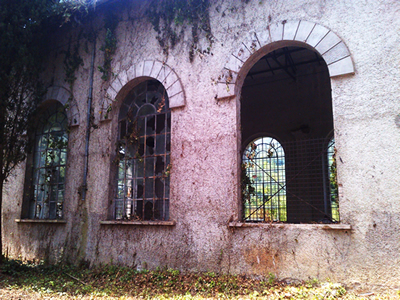 La Centrale Idroelettrica di Muro Lucano, costruita a partire dal 1915, contestualmente alla Diga, rappresentava, insieme ad essa, il fulcro del progetto di sviluppo economico che Francesco Saverio Nitti intendeva perseguire nel territorio e nel meridione intero. Costato 900.000 lire, l’impianto, alimentato dall’acqua defluita attraverso la diga, riforniva di elettricità diversi comuni attraverso due linee di trasmissione Bella-Muro, Ruoti, Avigliano, Potenza, Genzano, Pietragalla, Acerenza, Banzi da un lato; Muro Lucano, Castelgrande, Pescopagano, Calitri dall’altro. L’impianto, composto da due gruppi di 750 HP, con previsione di un terzo di 1500 HP, entra a pieno regime nel 1920, e funzionò correttamente fino al 1970, anno in cui, in seguito alla ricognizione di danni strutturali nella diga, la produzione di energia venne sospesa e, poco dopo, l’impianto venne definitivamente bloccato. Ad oggi, nonostante progetti di recupero, la centrale è in disuso e chiusa al pubblico.
La Centrale Idroelettrica di Muro Lucano, costruita a partire dal 1915, contestualmente alla Diga, rappresentava, insieme ad essa, il fulcro del progetto di sviluppo economico che Francesco Saverio Nitti intendeva perseguire nel territorio e nel meridione intero. Costato 900.000 lire, l’impianto, alimentato dall’acqua defluita attraverso la diga, riforniva di elettricità diversi comuni attraverso due linee di trasmissione Bella-Muro, Ruoti, Avigliano, Potenza, Genzano, Pietragalla, Acerenza, Banzi da un lato; Muro Lucano, Castelgrande, Pescopagano, Calitri dall’altro. L’impianto, composto da due gruppi di 750 HP, con previsione di un terzo di 1500 HP, entra a pieno regime nel 1920, e funzionò correttamente fino al 1970, anno in cui, in seguito alla ricognizione di danni strutturali nella diga, la produzione di energia venne sospesa e, poco dopo, l’impianto venne definitivamente bloccato. Ad oggi, nonostante progetti di recupero, la centrale è in disuso e chiusa al pubblico.
 The Muro Lucano's artificial lake was the first to be built in southern Italy, by will of the minister of the agriculture Francesco Saverio Nitti. According to him, this construction had to represent “the first evidence of the economic change in southern Italy”. For this purpose, a natural basin, able to contain 10 million cubic meters of water, was used. The works for the building of the dam, projected by the engineer Angelo Amodeo, officially began in October 1914, with state funding, after some political and economic arguments. The work lasted over a year, and the dam was inaugurated on the 25th of January 1916. It is 19 metres thick at the base and 5 at the top. The lake, named “Lago Nitti”, was not only a tourist attraction, but also provided water to run the hydroelectric power station located downstream. The water flowed through six spillways, with a flow of 600 litres per second. In the 1970s, due to low structural resistance and instability of the rocks, the lake was emptied and the dam structure closed to the public.
The Muro Lucano's artificial lake was the first to be built in southern Italy, by will of the minister of the agriculture Francesco Saverio Nitti. According to him, this construction had to represent “the first evidence of the economic change in southern Italy”. For this purpose, a natural basin, able to contain 10 million cubic meters of water, was used. The works for the building of the dam, projected by the engineer Angelo Amodeo, officially began in October 1914, with state funding, after some political and economic arguments. The work lasted over a year, and the dam was inaugurated on the 25th of January 1916. It is 19 metres thick at the base and 5 at the top. The lake, named “Lago Nitti”, was not only a tourist attraction, but also provided water to run the hydroelectric power station located downstream. The water flowed through six spillways, with a flow of 600 litres per second. In the 1970s, due to low structural resistance and instability of the rocks, the lake was emptied and the dam structure closed to the public.
